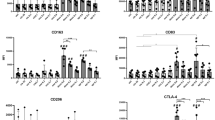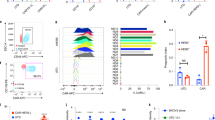Abstract
Purpose. In order to evaluate the possibility of synergistic antitumor gene therapy by the gene delivery of monocyte chemotactant protein-1 (MCP-1/MCAF/IE), the effect of a biological response modulater for macrophages on tumor progression of gene transfected tumor cells was studied.
Methods. Cachexia-inducing adenocarcinoma cells (cell line colon 26, clone 20) were transfected with either a control plasmid or MCP-1 cDNA.
Results. The production of MCP-1 reached 70-80 ng/ml in vitro when transfectant cells were cultured at a cell density of 1 × 105 cells/ml for 3 days. Transfection of MCP-1 cDNA did not affect the growth ratein vitro. Also, MCP-1-transfectants formed tumors after intra-footpad inoculation similar in size to the parental cells. The number of infiltrating macrophages in the primary tumor of the transfectant rapidly increased from the 3rd to 5th day after inoculation as revealed by immunohistochemical staining using an antibody against mouse macrophages. An earlier, greater, but no longer-lasting increase in tumor-infiltrating macrophages was induced in tumors by MCP-1 transfection was compared to that induced by the parent cells. On the 10th day after the inoculation, the tumor-infiltrating macrophages in mice inoculated MCP-1 transfectants were decreased to a level similar to that of the parent cells. Groups of mice were treated intraperitoneally with LPS at different times after the inoculation. Tumor cells producing high levels of MCP-1 were significantly lysed by macrophages treated with LPS, whereas parental or control transfected cells were not.
Conclusions. Combination immunotherapy can provide a rationale for the application of MCP-1 treatment to increase immunological responses to cancer.
Similar content being viewed by others
REFERENCES
E. Nakashima, N. Mukaida, Y. Kubota, K. Kuno, K. Yasumoto, F. Ichimura, I. Nakanishi, M. Miyasaka, and K. Matsushima. Human MCAF gene transfer enhances the metastatic capacity of a mouse cachectic adenocarcinoma cell line in vivo. Pharm Res. 12(11):1598–1604 (1995).
H. Hock, M. Dorsch, U. Kunzendorf, Z. Qin, T. Diamantstein, and T. Blankenstein. Mechanisms of rejection induced by tumor cell-targeted gene transfer of interleukin 2, interleukin 4, interleukin 7, tumor necrosis factor, or interferon gamma. Proc Natl Acad Sci USA 90(7):2774–8 (1993).
Z. Qin, K. S. Kruger, U. Kunzendorf, H. Hock, T. Diamantstein, and T. Blankenstein. Expression of tumor necrosis factor by different tumor cell lines results either in tumor suppression or augmented metastasis. J. Exp Med. 178(1):355–60 (1993).
D. A. Clark, H. W. Hirte, and R. N. Buick. Human ovarian carcinoma: evidence for patient-related differences in susceptibility to cytotoxic effectors that attack different cellular subpopulations within a tumour. Br J Cancer. 58(4):415–8 (1988).
D. D. Taub, P. Proost, W. J. Murphy, M. Anver, D. L. Longo, D. J. Van, and J. J. Oppenheim. Monocyte chemotactic protein-1 (MCP-1),-2, and-3 are chemotactic for human T lymphocytes. J Clin Invest. 95(3):1370–6 (1995).
B. J. Rollins and M. E. Sunday. Suppression of tumor formation in vivo by expression of the JE gene in malignant cells. Mol Cell Biol. 11(6):3125–31 (1991).
B. J. Rollins. JE/MCP-1: an early-response gene encodes a monocyte-specific cytokine. Cancer Cells 3(12):517–24 (1991).
R. K. Singh and I. J. Fidler. Synergism between human recombinant monocyte chemotactic and activating factor and lipopolysaccharide for activation of antitumor properties in human blood monocytes. Lymphokine Cytokine Res. 12(5):285–91 (1993).
S. Huang, R. K. Singh, K. Xie, M. Gutman, K. K. Berry, C. D. Bucana, I. J. Fidler, and E. M. Bar. Expression of the JE/MCP-1 gene suppresses metastatic potential in murine colon carcinoma cells. Cancer Immunol Immunother. 39(4):231–8 (1994).
Y. Tanaka, H. Eda, K. Fujimoto, T. Tanaka, T. Ishikawa, and H. Ishitsuka. Anticachectic activity of 5′-deoxy-5-fluorouridine in a murine tumor cachexia model, colon 26 adenocarcinoma. Cancer Res. 50(15):4528–32 (1990).
Y. Furutani, H. Nomura, M. Notake, Y. Oyamada, T. Fukui, M. Yamada, C. G. Larsen, J. J. Oppenheim, and K. Matsushima. Cloning and sequencing of the cDNA for human monocyte chemotactic and activating factor (MCAF). Biochem Biophys Res Commun. 159(1):249–55 (1989).
P. Gunning, J. Leavitt, G. Muscat, S. Y. Ng, and L. Kedes. A human beta-actin expression vector system directs high-level accumulation of antisense transcripts. Proc Natl Acad Sci USA. 84(14):4831–5 (1987).
C. Chen and H. Okayama. High-efficiency transformation of mammalian cells by plasmid DNA. Mol Cell Biol. 7(8):2745–52 (1987).
Y. Ko, N. Mukaida, A. Panyutich, N. N. Voitenok, K. Matsushima, T. Kawai, and T. Kasahara. A sensitive enzyme-linked immunosorbent assay for human interleukin-8. J Immunol Methods 149(2):227–35 (1992).
Y. Nakano, T. Kasahara, N. Mukaida, Y. C. Ko, M. Nakano, and K. Matsushima. Protection against lethal bacterial infection in mice by monocyte-chemotactic and-activating factor. Infect Immun. 62(2):377–83 (1994).
K. Matsushima, C. G. Larsen, G. C. DuBois, and J. J. Oppenheim. Purification and characterization of a novel monocyte chemotactic and activating factor produced by a human myelomonocytic cell line. J Exp Med. 169(4):1485–90 (1989).
M. W. Carr, S. J. Roth, E. Luther, S. S. Rose, and T. A. Springer. Monocyte chemoattractant protein 1 acts as a T-lymphocyte chemoattractant. Proc Natl Acad Sci USA 91(9):3652–6 (1994).
J. M. Wang, A. Hishinuma, J. J. Oppenheim, and K. Matsushima. Studies of binding and internalization of human recombinant monocyte chemotactic and activating factor (MCAF) by monocytic cells. Cytokine. 5(3):264–75 (1993).
R. K. Singh, K. Berry, K. Matsushima, K. Yasumoto, and I. J. Fidler. Synergism between human monocyte chemotactic and activating factor and bacterial products for activation of tumoricidal properties in murine macrophages. J Immunol. 151(5):2786–93 (1993).
Author information
Authors and Affiliations
Corresponding author
Rights and permissions
About this article
Cite this article
Nakashima, E., Kubota, Y., Matsushita, R. et al. Synergistic Antitumor Interaction of Human Monocyte Chemotactant Protein-1 Gene Transfer and Modulator for Tumor-Infiltrating Macrophages. Pharm Res 15, 685–689 (1998). https://doi.org/10.1023/A:1011906600304
Issue Date:
DOI: https://doi.org/10.1023/A:1011906600304




